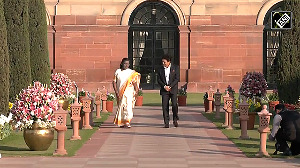At last the Lok Sabha has passed the Fiscal Responsibility and Budget Management Bill. There is a consensus among observers that it is a watered-down version of the original intentions. Explicit targets for the reduction of the fiscal and revenue deficits as well as the ceiling on government borrowing have been removed from the draft.
It was originally envisaged that there should be a cap on public debt at 50 per cent of Gross Domestic Product. Instead of mandating a half per cent cut in deficits annually, the revised version says that the government should undertake appropriate measures to eliminate revenue deficit by March 31,2008 and let the targets to be set for annual reduction in fiscal and revenue deficits remain till then.
As could be expected, there is an enabling clause to escape from the rigours of the discipline on grounds of national calamity, security or other exceptional circumstances. However, there is an important provision, which has been retained from the original. The Bill seeks to bar the Reserve Bank of India from operating in the primary market for government securities from April 1, 2006.
However, it could lend to the government directly in case of exceptional situations like natural calamities. It also prohibits direct borrowing by the Centre from the RBI except for meeting temporary cash needs. A parliamentary committee, which also has members from the Opposition parties, diluted the draft Bill.
Is it because of foresight that the draft law may be a nuisance to future governments formed by the opposition? The foresight is commendable but for wrong reasons! An anti-climax of the legislation is the clause, made by way of abundant caution, that no civil court will have jurisdiction to question the legality of any action or decision taken by the Government under the Act, if and when passed.
It is perhaps an index of the lack of seriousness in implementing the reform. The Act will be on par with the Directive Principles of State Policy in the Constitution, which are not justiciable.
The experience with debt ceilings in the US are not encouraging. It was introduced first during World War I at $11.5 bn. It rose to $300 bn during the next World War. In the eighties of the last century, the Congress had to raise it several times during a year. The Act of October 13,1984 established the debt limit at $1,823,800 million.
Subsequently there were further increases. During the current tenure of President Bush Jr. the limit was raised by $450 bn to $6,399,975,000,000 -- or approximately $6.4 trillion -- a few months ago.
The limit was being reached in February this year. Hence the US Treasury sought a further increase arguing that any default in payment of bills would result in international repercussions, unsettling bond markets, driving up interest rates and weakening the world economy.
After wrangling over the President's proposals for the next fiscal, the House of Representatives passed a compromise budget and sent a bill to the Senate, raising the ceiling to $7.38 trillion. The Senate is yet to vote but one may safely assume that it will be passed.
The experience of the US shows that, despite a strong lobby existing both in the Congress and among the public against debt, the ceiling has been merrily raised from time to time, making a mockery of the law. In India the public is least concerned with the matter and Parliamentarians have more important and urgent issues on their agenda.
As James Clarke said: "A politician thinks of the next election; a statesman thinks of the next generation." Thus any ceiling in India, if ever prescribed, would meet the same fate as in the US. Recently Alan Greenspan, President of the Federal Reserve System, said at a House hearing that such official ceilings did nothing to force deficit reduction.
But one salient aspect of the foreign experience is that every time the US government had to seek approval of a raise in the ceiling there was a national debate and it was put on the defensive. During President Clinton's time some government establishments were closed for a few days because there was no money to pay the staff!
On the other hand, in India the growth of debt goes on without any questions being asked. Even the Appropriations and Demand for Grants have no sanctity. How else can one explain the phenomenon of both the Centre and the states approaching the legislatures to 'regularise' excess spending after the event?
One has no hope of the deficits coming down in the near future. The finance minister has said that a half of revenues goes towards interest payments. If one adds 'holy cows' like subsidies and defence, and those charged on the Consolidated Fund of India (in addition to interest) the leeway for any cut down in expenditure is limited.
The country is caught in an internal debt trap as it borrows even to pay interest. It is like being in quicksand where the more you try to get out the more you sink in. The only hope is in raising revenues. What is lacking is the political will to enforce tax laws. Even with the existing rates of income-tax there is a mine of revenue waiting to be tapped if only efforts are made to nab tax-evaders, especially in big cities.
As regards the ban on borrowing by the government from the RBI, it is a welcome feature. There is such a prohibition in the US too. But there is no ways and means arrangement there. It is quite likely that it will continue in India even under the new dispensation, given the rider to the Bill.
The autonomy of the Federal Reserve System ensures that there is a counterbalancing force to meet fiscal profligacy. In the US, fiscal loosening in the past was neutralised by a tightening monetary policy against the wishes of the government. Would it work in India in the absence of central bank autonomy? I am not sure.
As it is, there is a provision in the Bill for the the Government to access the monetary tap of the RBI. Even otherwise an obliging RBI can easily find ways to help the Government. If the market conditions are tight and a new issue of securities is likely to face difficulties, the central bank can exercise 'moral suasion' (of the wrong type!) on the system.
Banks may be informally asked to purchase the new issues on the understanding that the RBI will buy them back in the secondary market soon, thus releasing the funds.






 © 2025
© 2025